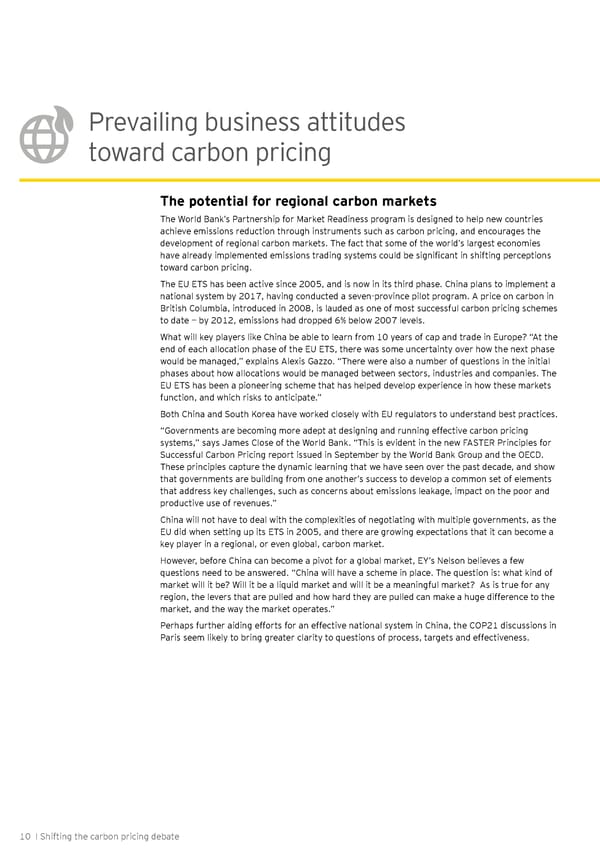Prevailing business attitudes toward carbon pricing The potential for regional carbon markets The World Bank’s Partnership for Market Readiness program is designed to help new countries achieve emissions reduction through instruments such as carbon pricing, and encourages the development of regional carbon markets. The fact that some of the world’s largest economies have already implemented emissions trading systems could be significant in shifting perceptions toward carbon pricing. The EU ETS has been active since 2005, and is now in its third phase. China plans to implement a national system by 2017, having conducted a seven-province pilot program. A price on carbon in British Columbia, introduced in 2008, is lauded as one of most successful carbon pricing schemes to date — by 2012, emissions had dropped 6% below 2007 levels. What will key players like China be able to learn from 10 years of cap and trade in Europe? “At the end of each allocation phase of the EU ETS, there was some uncertainty over how the next phase would be managed,” explains Alexis Gazzo. “There were also a number of questions in the initial phases about how allocations would be managed between sectors, industries and companies. The EU ETS has been a pioneering scheme that has helped develop experience in how these markets function, and which risks to anticipate.” Both China and South Korea have worked closely with EU regulators to understand best practices. “Governments are becoming more adept at designing and running effective carbon pricing systems,” says James Close of the World Bank. “This is evident in the new FASTER Principles for Successful Carbon Pricing report issued in September by the World Bank Group and the OECD. These principles capture the dynamic learning that we have seen over the past decade, and show that governments are building from one another’s success to develop a common set of elements that address key challenges, such as concerns about emissions leakage, impact on the poor and productive use of revenues.” China will not have to deal with the complexities of negotiating with multiple governments, as the EU did when setting up its ETS in 2005, and there are growing expectations that it can become a key player in a regional, or even global, carbon market. However, before China can become a pivot for a global market, EY’s Nelson believes a few questions need to be answered. “China will have a scheme in place. The question is: what kind of market will it be? Will it be a liquid market and will it be a meaningful market? As is true for any region, the levers that are pulled and how hard they are pulled can make a huge difference to the market, and the way the market operates.” Perhaps further aiding efforts for an effective national system in China, the COP21 discussions in Paris seem likely to bring greater clarity to questions of process, targets and effectiveness. 10 I Shifting the carbon pricing debate
 Shifting the Carbon Pricing Debate Page 9 Page 11
Shifting the Carbon Pricing Debate Page 9 Page 11